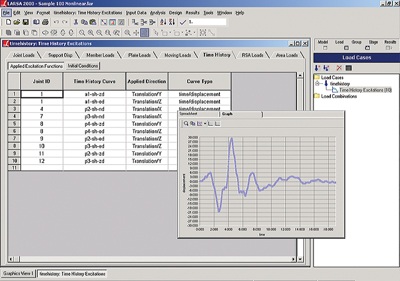4D BRIDGE SERIES - Features
Advanced Analysis Types
Nonlinear and inelastic analysis of structures has become increasingly important in the study of structural response.
In addition to the standard analysis types, the following advanced analysis types are included.
Nonlinear Time History Analysis

In LARSA 4D, nonlinear time history is carried out by using a combination of the Newmark-Beta time integration algorithm and the full Newton-Raphson method using iterations within each integration time-step. Excitations can be in the form of force, multi-support displacement, or uniform base acceleration.
In combination with LARSA 4D's inelastic element library, the nonlinear time history analysis can be used to evaluate demand capacity in large, complex structures subject to seismic loads.
Result graphing tools for plotting displacement, relative displacement, force and other time history results are easy to use with multiple output options.
Nonlinear Pushover/Progressive Collapse/Buckling Analysis

Plastic pushover performs a nonlinear inelastic analysis on a load case, continuously increasing the loading on the structure until a stopping criterion is met, such as maximum loading displacement at a particular joint in a particular direction. Plastic pushover analysis is a simplified form of progressive collapse.
The progressive collapse analysis simulates structural loss such as cable-snapping. LARSA's nonlinear solver uses arc length auto-stepping to increase loads at critical regions on the post-buckling stress-strain curve. This analysis is performed using LARSA 4D's inelastic element library.
Moment-Curvature Analysis

Moment-curvature analysis is used to determine axial force nonlinear moment-curvature behavior of a cross-section which is then assigned to a hysteretic beam element in the LARSA 4D bridge model.
Once defined, a "family" of moment-curvature curves is created to define element behavior over a user-specified range of axial force values.
Moment-curvature analysis determines the inelastic properties of a reinforced concrete cross-section to establish the displacement capacity using pushover or time history analysis.

